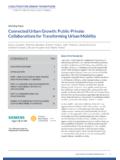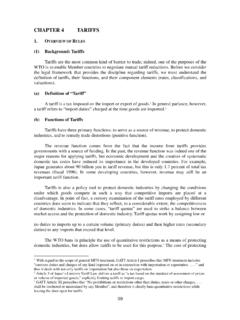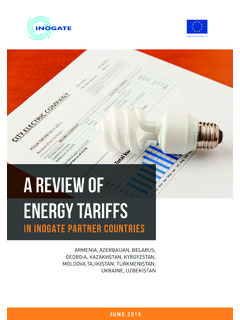Transcription of EMERGING GREEN TARIFFS IN U.S. REGULATED ELECTRICITY …
1 ISSUE BRIEF. UPDATED SEPTEMBER 2017. EMERGING GREEN . TARIFFS IN REGULATED . ELECTRICITY MARKETS. LETHA TAWNEY, PRIYA BARUA, CELINA BONUGLI. INTRODUCTION. ELECTRICITY customers from residential to industrial increasingly want their energy supply to be sourced from renewable energy. Renewable energy provides environmental benefits and reputational advantages, and it may offer opportunities to reduce their ELECTRICITY bills and protect themselves against volatile fossil fuel- based power prices. The Corporate Renewable Energy Buyers' Principles represent 53 million megawatt- hours (MWh) of renewable energy demand per year by 2020 (WRI and WWF 2016).
2 Launched by WRI and WWF, total signatories have grown from a dozen companies to 70. As the Principles make clear (see Box 1), signatories expect renewable energy to provide more than environmental benefits (as demonstrated by the Renewable Energy Certificates [RECs]) they also want renewable ELECTRICITY that is designed as a long-term, fixed-priced product. Utilities are weighing how to meet GREEN TARIFFS , or riders, are an emerg- this evolving customer interest in ing option for customers in tradi- CONTENTS renewable energy. In restructured tional, REGULATED markets.
3 Offered by states that provide easily accessible local utilities and approved by state 6 Colorado customer choice 13 states and the public utility commissions (PUCs), 8 Kentucky District of Columbia (Bonugli 2017) these programs allow eligible cus- 9 Michigan customers can shop for ELECTRICITY tomers to buy both the energy from providers that offer fixed-price a renewable energy project and the 11 Minnesota renewable energy options, including RECs. Since the first GREEN tariff was 13 Nebraska the environmental attributes ( , proposed by NV Energy in 2013, 17.)
4 15 Nevada RECs). In the remaining states, GREEN TARIFFS in 13 states have been which are traditional, REGULATED proposed or approved. GREEN TARIFFS 16 New Mexico markets, options are more limited. cater to customers' preference for a 18 North Carolina more direct financial connection to 19 Utah RMP Schedule 32 The simplest and most available renewable energy projects, ideally 21 Utah RMP Schedule 34 option for customers in these states within the same service territory or has typically been a utility GREEN grid distribution area. GREEN TARIFFS 22 Virginia APCo Rider REO pricing program.
5 1 These programs can also offer greater economic value 24 Virginia Dominion Energy offer RECs, often from local renew- to customers than unbundled RECs Schedule RG able energy projects, at an additional alone. 25 Virginia Dominion Energy cost to standard utility ELECTRICITY Schedule MBR charges. The customer doesn't have Through GREEN TARIFFS , traditional the opportunity to economically ben- utilities may be able to offer renew- 27 Virginia Dominion Energy efit from the fixed cost of the renew- able energy services as attractive as Schedule CRG. able energy project that created the those that buyers are able to access 29 Washington RECs or protection against volatile in restructured states or through 31 Wisconsin fossil fuel prices.
6 Third-party financed behind-the- meter renewable energy services. 32 Wyoming THE CORPORATE RENEWABLE ENERGY BUYERS' PRINCIPLES. BOX 1. The Corporate Renewable Energy Buyers' Principles establish the framework for what customers are seeking from ELECTRICITY providers: 1. Greater choice in options to procure renewable energy 2. Cost competitiveness between traditional and renewable energy rates 3. Access to longer-term, fixed-price renewable energy 4. Access to projects that are new or help drive new projects in order to reduce energy emissions beyond business as usual 5.
7 Increased access to third-party financing vehicles, as well as standardized and simplified processes, contracts,and financing for renewable energy projects 6. Opportunities to work with utilities and regulators to expand the choices for buying renewable energy WRI's Technical Note further explores these principles in detail (Bonugli 2017). 2|. EMERGING GREEN TARIFFS in REGULATED ELECTRICITY Markets In some cases, GREEN TARIFFS may The table excludes GREEN pricing utilities and customers when appli- also provide greater flexibility and programs that rely on RECs but have cable.
8 This table is regularly updated, lower transaction costs than alterna- no energy-pricing component; for but many utilities are moving tives, given utilities' expertise and example, where RECs are a pre- forward quickly to offer new GREEN decades of experience in integrating mium charge on top of the full retail TARIFFS . For complete and up-to-date generation technologies, aggregat- ELECTRICITY rate. It also excludes utility details of each GREEN tariff, see the ing customer demand, and reliably programs that can be classified as appropriate docket or filing number delivering least-cost community choice aggregation or listed in the table, or contact the community solar (see Box 2).
9 Offering utility and reference the This issue brief provides detailed interactive Renewable Energy information, organized in the follow- For additional information on utility Map: A Guide for Corporate Buyers. ing table, on the GREEN tariff propos- renewable energy products that are als and offerings for commercial and not considered GREEN TARIFFS , see the industrial (C&I) customers in regu- Technical Note (Bonugli 2017). lated markets in the United States. Figure 1 lists the states with pending Methodology The criteria and characteristics high- GREEN TARIFFS , or or approved GREEN TARIFFS to date.
10 Lighted in this table include customer riders, are an costs, facility flexibility, contract time The role of this issue brief and WRI's additional GREEN tariff work commitment, program size limits, EMERGING option procurement lead,4 and risk manage- is outlined in Box 3. ment, among others. These are the for customers GREEN TARIFFS , or riders, are an EMERGING option for customers in characteristics that most often drive customers' purchasing decisions. in traditional, traditional, REGULATED markets. The data presented is compiled from REGULATED markets.









